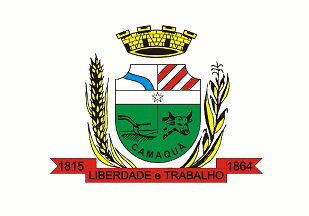 image by Dirk Schönberger,
10
January 2012
image by Dirk Schönberger,
10
January 2012Source: http://www.camaqua.rs.gov.br/005/00502001.asp?ttCD_CHAVE=36046

Last modified: 2012-02-11 by ian macdonald
Keywords: rio grande do sul | camaquã |
Links: FOTW homepage |
search |
disclaimer and copyright |
write us |
mirrors
 image by Dirk Schönberger,
10
January 2012
image by Dirk Schönberger,
10
January 2012
Source:
http://www.camaqua.rs.gov.br/005/00502001.asp?ttCD_CHAVE=36046
A white flag bearing the municipal arms.
Official website is at
http://www.camaqua.rs.gov.br
Dirk Schönberger,
10 January 2012
The municipality of Camaquã (60,383 inhabitants in 2000; 1,680 sq. km) is
located in central-southern Rio Grande do Sul, 110 km from Porto Alegre.
Camaquã emerged on 9 December 1815 when Captain Joaquim Gonçalves da
Silva, considered as the founder of the municipality, was allowed to build a
chapel dedicated to St. John the Baptist. The place where the chapel was
built is located today in Capela Velha (Old Chapel), the 8th district of
Camaquã. A new chapel was erected in 1844 by Ana Gonçalves da Silva Meirelles,
Joaquim's daughter, on the site of the today's town of Camaquã; accordingly,
some historians consider Lady Ana as the true founder of the town. The Gonçalves were rich land owners: General Bento Gonçalves, one of the heroes
of the Rio Grande Republic, was Joaquim's son; after the suppression of the
Republic, he retired in his estate of Cristal. His mother was the grand
daughter of Jerônimo de Ornellas, the owner of the domain were Porto Alegre
would develop. The municipality of São João Batista de Camaquã, named for
the chapel, was created on 19 April 1864 by Municipal Law no. 569.
The
origin of the name of Camaquã is quite obscure. The most probable
explanation, proposed by Antonio Cândido Silveira Pires, alludes to the
Tupi-Guarani word "icabaquã", meaning "a turbulent river". Accordingly, the
municipality was probably named for river Camaquã that waters it.
The flag of Camaquã is white with the municipal coat of arms in the middle.
The coat of arms of Camaquã is prescribed by Municipal Law No. 167 of 30
August 1960. The arms are made of a ducal shield surmounted with a mural crown
representing its town status. The shield is divided in three fields. The first
field is divided in two parts. The left part represents river Camaquć, the main
source of income of the municipality, on a golden background. The right stripe,
made of three diagonal red stripes on a white background, symbolizes the three
main revolutions experienced by the State, during which the municipal territory
was watered with its sons' blood. The first stripe represents the War of the
Ragamuffins, and, especially, the fighting led by Garibaldi near the mouth of
river Camaquć. The second stripe recalls the 1893 Revolution, and the third
recalls the 1923 Revolution. The second field is a white horizontal stripe
charged with a five-pointed star representing peace fecundating and allowing the
development of agriculture and cattle-breeding, which are represented in the
third, lower part of the shield. Green represents our fields and "coxilhas"
(isolated hills, typical of the local landscape), with symbols of agriculture
and cattle-breeding [a plough and a bovine head, respectively). Below the shield
is placed a red scroll charged with the municipal motto reflecting the main
aspirations of the inhabitants, "LIBERDADE e TRABALHO" (Freedom and Work),
flanked by the years "1815" and "1864", the foundation years of the first chapel
and of the municipality, respectively. The shield is flanked by a wheat spike
and a maize plant, symbolizing the main agricultural resources of the
municipality.
Ivan Sache, 14 January 2012